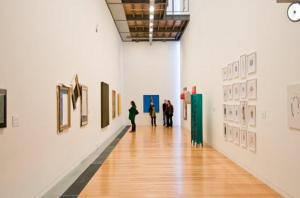 A little while ago I was trying to write a response to an article about children and art galleries. In it I was both arguing that if galleries bore children, then that’s more a problem with the gallery than the child, and also talking about how valuable visiting galleries as a child was to me. And that’s when I began struggling with the post, because when I was talking about making galleries better suited to children, I was thinking of light, noisy spaces with lots of movement, where it was okay to run around and be noisy, where you could interact in multiple ways with the art. And when I was writing about why galleries were such a refuge for me, I was remembering how they were quiet with clear sets of rules that were laid out on signs, and how often staff were, once they realised my interest, happy to have a conversation with me where they treated me as an adult, and it was a straightforward conversation about things, not small talk with all its little tricks and conventions.
A little while ago I was trying to write a response to an article about children and art galleries. In it I was both arguing that if galleries bore children, then that’s more a problem with the gallery than the child, and also talking about how valuable visiting galleries as a child was to me. And that’s when I began struggling with the post, because when I was talking about making galleries better suited to children, I was thinking of light, noisy spaces with lots of movement, where it was okay to run around and be noisy, where you could interact in multiple ways with the art. And when I was writing about why galleries were such a refuge for me, I was remembering how they were quiet with clear sets of rules that were laid out on signs, and how often staff were, once they realised my interest, happy to have a conversation with me where they treated me as an adult, and it was a straightforward conversation about things, not small talk with all its little tricks and conventions.
That’s not an activist scenario, but I do think it’s a good illustration of how there is often a gap between what we perceive as ‘accessibility’ and what actually makes a space accessible, and how this conflict often hits autistic people pretty hard.
Many people in activist communities have woken up, at least partially, to the idea that accessible means more than just ‘has wheelchair ramps’ but needs to incorporate the needs of people with a wide range of impairments. It’s being increasingly recognised that accessibility isn’t just relevent for disabled people, but for (say) parents, those on low incomes, those with limited transport options and so on, and to look outside these as discrete groups, which is important not least because many accessibility needs overlap
But somewhere along the way, the idea of accessibility has become divorced from actual people and what they need to fully participate and beome an athestic, a vague set of ideas about what an accessible environment is like.
The effect of this isn’t limited to autistic people, of course – an article by a local group about one of their events recently used the term “accessible activism”. The only access to that event was up a flight of stairs – I can only assume that they used the term accessible to mean it was a relaxed, fun environment where you weren’t expected to have a lot of background knowledge or commit to anything big. But when accessibility comes to mean “shiny friendly and cool”, it tends to come with a lot of noise, a lot of structurelessness and a lot of emphasis on the social side – all things which have the reverse effect for most autistic people.
I write this as a call to think about what really does make spaces accessible – and in the next post I’ll be sharing some ideas about what people – both autistic, NT and otherwise – can do to make activism and activist spaces more accessible for autistic people.
This is part two of a six part series on autism and activism. I will be linking other post below as they are posted:
Part 1 Introduction
Part 2 Accessibility and ‘Accessibility’
Part 3 Immediate Ideas
Part 4 Getting to the heart of it
Part 5 On the positive side…
Part 6 Looking forward
